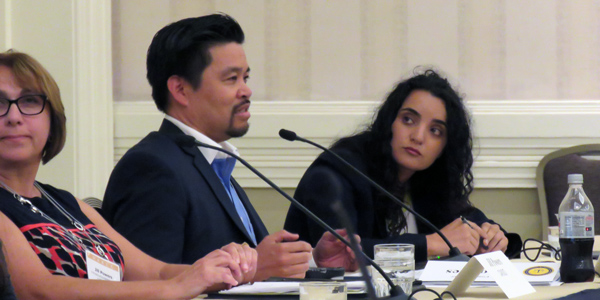By Jason Fordney
SAN DIEGO — CAISO expects new aggregated distributed energy resources to enter its markets this year, creating new technical and regulatory challenges as the grid operator works to integrate them without affecting reliability.
Industry officials discussed the development in detail at a July 17 panel at the National Association of Regulatory Utility Commissioners Summer Policy Summit.
FERC in June 2016 conditionally approved CAISO’s proposed rules to allow aggregated resources to participate in the wholesale markets. (See CAISO Tariff Change Would Extend Market to DER.) Later in November, the commission also issued a separate Notice of Proposed Rulemaking (RM16-23, AD16-20) that would allow DER to participate in other wholesale electricity markets across the country.
CAISO is ironing out implementation policies so that DER aggregators can begin operating in its markets this year. DER aggregators can be generators, load-side participants, storage devices or a mixture, and they can also participate as scheduling coordinators that distribute CAISO dispatch instruction from their individual energy sources.
DER is dispatched without knowledge of the exact impact on grid operations, and the effect on the system is difficult to quantify because of many different interconnections and ways to connect, said Mark Esguerra, director of integrated grid planning for Pacific Gas and Electric. It also requires more coordination between the transmission and distribution system operators.
Visibility into DER behavior “is something we are trying to wrap our arms around,” Esguerra said, adding that DER “creates new operational challenges that we all have to consider here.”
Manal Yamout, vice president of policy and markets for Advanced Microgrid Solutions, said DER can provide a suite of services at the transmission and distribution levels. The company is developing 50 MW of DER with Southern California Edison, among other projects.
“This is happening now,” she said, saying the discussion around DER is often conceptual or forward-looking. “Even though this might seem far away … these projects are here, and in many ways, we are kind of breaking down the barriers as we go. … This isn’t just about California.”
DER is often discussed in the context of balancing intermittent renewables, but they can also provide capacity, ancillary services, resource adequacy to the utility and demand-side management to energy customers, Yamout said.
D.C. Public Service Commissioner Willie Phillips said he is often asked about the reliability impacts of DER and aggregation.
Esguerra said that reliability officials are looking at the integration of DERs, and that there is an ongoing shift from the central power station model.
“I think there is work that still needs to be done, in terms of certifications and standards,” if the grid is going to rely more on DER, Esguerra said.
So far, Apparent Energy, Galt Power, Olivine and San Diego Gas & Electric have applied to become DER providers in California, according to CAISO.





